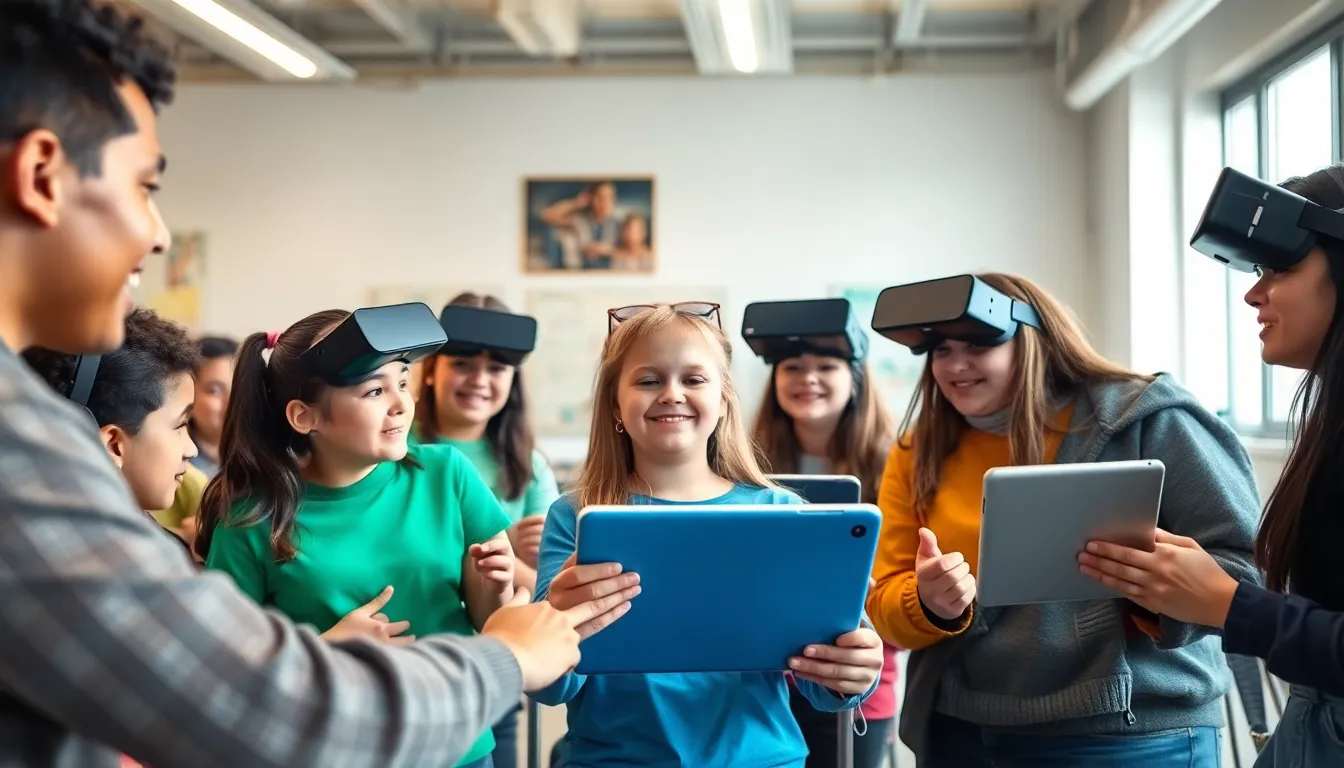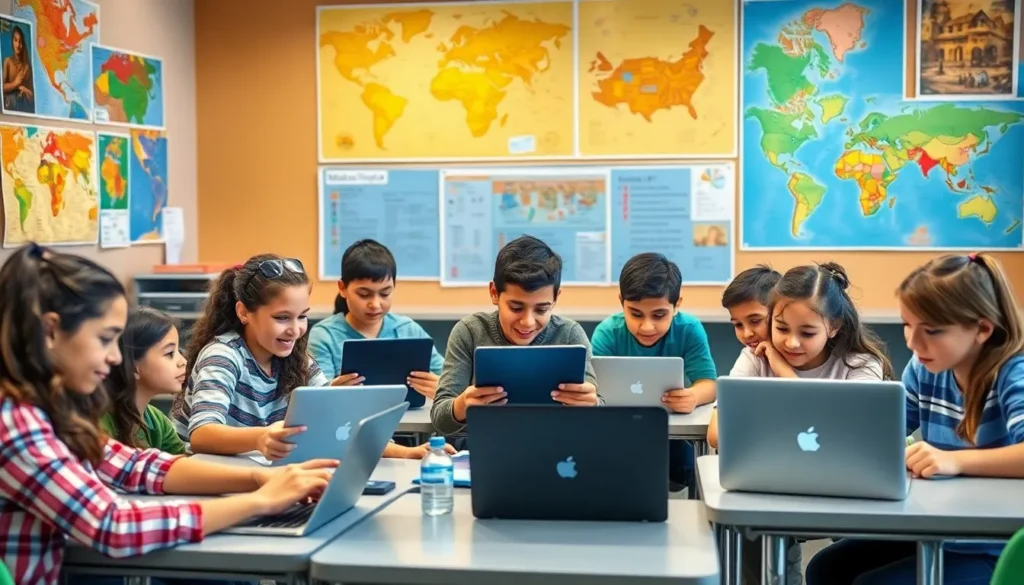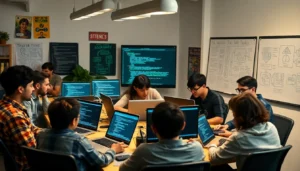Table of Contents
ToggleIn a world where students can learn about ancient civilizations while sitting in their pajamas, social studies technology resources are the secret sauce to making history come alive. Gone are the days of dusty textbooks and uninspired lectures. With a few clicks, teachers can access a treasure trove of interactive tools that transform the mundane into the magnificent.
Overview of Social Studies Technology Resources
Social studies technology resources play a vital role in modern education. They encompass various tools designed to enrich students’ learning experiences. Interactive simulations allow learners to visualize historical events, enhancing comprehension. Virtual reality applications create immersive environments for exploring ancient civilizations.
Multimedia presentations, such as videos and podcasts, present complex concepts in engaging formats. Digital maps provide visual context to geographical topics, offering insights into cultural landscapes. Online databases enable students to access primary sources, fostering critical thinking skills.
Educational websites, such as National Geographic Education and the Smithsonian Learning Lab, offer valuable materials for teachers and students alike. These platforms often include lesson plans, interactive quizzes, and discussion forums. Collaboration tools, like Google Classroom, facilitate group projects and enhance communication among students.
Moreover, social media platforms provide spaces for discussions and knowledge sharing. Students can follow historical figures, museums, and educational organizations to stay updated on relevant topics. Mobile applications offer on-the-go learning opportunities, ensuring access to educational resources anytime, anywhere.
Incorporating these technology resources transforms traditional social studies curricula. Engaging tools lead to increased student participation and motivation. Teachers can create customized learning experiences utilizing diverse formats and methodologies. With these resources, educators facilitate deeper connections between students and course material, fostering a more interactive learning environment.
Importance of Technology in Social Studies

Technology plays a crucial role in modern social studies education. It enhances learning by facilitating interactive and immersive experiences.
Enhancing Engagement and Understanding
Engagement levels increase when students interact with historical material through technology. Multimedia presentations, videos, and simulations cater to varied interests and enhance comprehension. Learning becomes more impactful with the use of virtual reality, which immerses students in historical contexts. Students visualize events, making connections to the past more tangible. Increased participation leads to deeper understanding, encouraging students to explore topics beyond the classroom. A shift from passive to active learning models significantly boosts motivation and retention of information.
Supporting Diverse Learning Styles
Technology accommodates distinct learning preferences among students. Visual learners benefit from videos and infographics, while auditory learners find podcasts and discussions more engaging. Kinesthetic learners thrive in interactive simulations, allowing hands-on exploration of concepts. These resources ensure students access learning tools that best suit their needs. With platforms that promote collaboration, students can engage in group projects and discussions that enhance their understanding. Tailoring resources to individual learning styles empowers students and fosters a conducive environment for knowledge acquisition.
Types of Social Studies Technology Resources
Various technology resources enhance social studies education by creating engaging and interactive experiences. The following types provide specific tools for teachers and students alike.
Digital Textbooks and E-Books
Digital textbooks and e-books serve as essential resources in social studies classrooms. They offer updated content and multimedia features that traditional textbooks lack. Students can easily access interactive elements like videos and links to primary sources. Additionally, digital formats often include built-in search functions that enable quick information retrieval. Teachers can assign readings and track student progress through e-book platforms. This accessibility and interactivity promote deeper learning and facilitate the exploration of diverse perspectives.
Interactive Learning Platforms
Interactive learning platforms stand out for their ability to engage students in a meaningful way. Programs like Google Earth and Nearpod allow students to visualize geographical locations and historical events. They can participate in interactive maps, quizzes, and simulations that encourage critical thinking. Educators leverage these platforms to create customized lessons tailored to class needs. These tools enable collaboration among students, fostering discussions that deepen understanding of complex topics. With regular updates and fresh content, interactive platforms keep lessons dynamic and relevant.
Educational Apps and Games
Educational apps and games capture students’ interest while enhancing their knowledge of social studies. Tools such as Kahoot! and Quizlet provide fun, gamified learning experiences. Many apps incorporate storytelling elements, making historical events relatable and engaging. Students can compete in quizzes or collaborate in team-based activities, which enhances retention of information. These apps often support various learning styles, accommodating both visual and auditory learners. Utilizing educational games in the classroom adds an element of excitement, helping students connect with content on a personal level.
Integrating Technology into the Curriculum
Integrating technology into the social studies curriculum enhances student engagement and comprehension. Various strategies promote effective implementation across classrooms.
Strategies for Effective Implementation
Educators can start by selecting resources that align with curriculum goals. Integrating interactive simulations allows students to visualize historical events directly. Teachers should also utilize multimedia presentations, encouraging diverse learning styles. Leveraging collaboration tools like Google Classroom fosters communication among students. Incorporating virtual reality applications immerses students in ancient civilizations, enhancing their educational experience. Encouraging regular training for educators on these tools maximizes their effective use. Using digital assessments helps monitor students’ progress in real time.
Challenges and Solutions
Challenges often arise during technology integration, such as limited access to devices. Addressing this requires enabling shared resources in classrooms and libraries. Another challenge involves varying tech proficiency among students. Offering workshops can bridge the gap in skills and comfort levels. Resistance to change from traditional methods may occur, so promoting the benefits of tech resources is essential. Continuous feedback from students helps refine strategies and ensure effective technology use. Collaborative planning among educators can also alleviate resistance and lead to successful implementation.
Future Trends in Social Studies Technology Resources
Social studies technology resources are evolving rapidly, driven by advancements in digital tools. Educators need to stay informed about these emerging technologies to maintain engaging learning environments.
Emerging Technologies to Watch
Augmented reality (AR) offers unique experiences that transform how students interact with historical content. Interactive mapping tools enhance geographic skills by allowing students to explore historical sites in real time. Gamification integrates competitive elements in learning, making study sessions more engaging. Podcasts serve as accessible learning materials, enabling auditory learners to consume information conveniently. Artificial intelligence-powered platforms analyze student performance, helping educators tailor lessons to individual needs. Virtual field trips enable immersive exploration of significant locations across the globe, making historical events more relatable. Students can also benefit from citizen science projects, where they contribute to real-world research while learning about social issues.
The Role of Artificial Intelligence
Artificial intelligence customizes learning pathways by analyzing student data and adapting content accordingly. AI-driven chatbots facilitate immediate assistance for students, answering questions and providing guidance on complex subjects. Machine learning algorithms enhance assessment tools by delivering personalized feedback based on individual performance. Educators access AI-generated analytics for insights on class trends, allowing them to make informed decisions about instructional methods. Furthermore, smart content offers personalized resources, helping students engage more deeply with varied topics. Predictive analytics can identify at-risk students, prompting timely intervention strategies from educators. Enhanced natural language processing develops sophisticated dialogue and interaction within educational platforms, fostering discussions that deepen understanding and engagement.
Social studies technology resources are revolutionizing the educational landscape. By integrating these tools into the curriculum, educators can foster a more engaging and interactive learning environment.
Students benefit from immersive experiences that not only enhance their understanding of historical events but also cater to diverse learning styles. As technology continues to evolve, the potential for innovative resources will only grow.
Embracing these advancements ensures that educators remain equipped to inspire and motivate students, ultimately transforming how history and social studies are taught and learned. The future of social studies education looks promising with the right tools and strategies in place.







